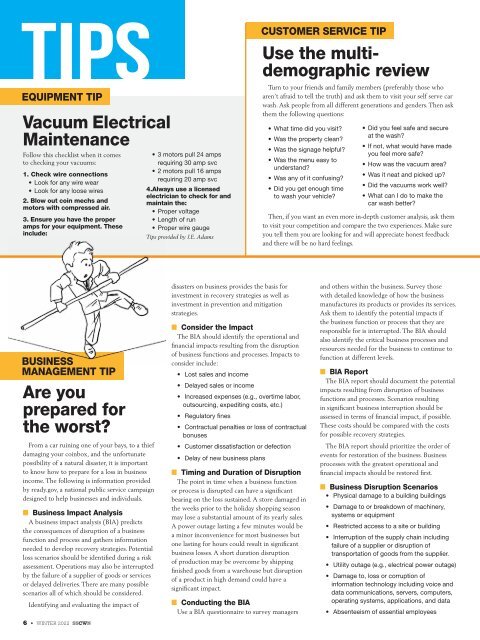WINTER2022_SSCWN_1-68-3
You also want an ePaper? Increase the reach of your titles
YUMPU automatically turns print PDFs into web optimized ePapers that Google loves.
TIPs<br />
EQUIPMENT TIP<br />
Vacuum Electrical<br />
Maintenance<br />
Follow this checklist when it comes<br />
to checking your vacuums:<br />
1. Check wire connections<br />
• Look for any wire wear<br />
• Look for any loose wires<br />
2. Blow out coin mechs and<br />
motors with compressed air.<br />
3. Ensure you have the proper<br />
amps for your equipment. These<br />
include:<br />
• 3 motors pull 24 amps<br />
requiring 30 amp svc<br />
• 2 motors pull 16 amps<br />
requiring 20 amp svc<br />
4.Always use a licensed<br />
electrician to check for and<br />
maintain the:<br />
• Proper voltage<br />
• Length of run<br />
• Proper wire gauge<br />
Tips provided by J.E. Adams<br />
CUSTOMER SERVICE TIP<br />
Use the multidemographic<br />
review<br />
Turn to your friends and family members (preferably those who<br />
aren’t afraid to tell the truth) and ask them to visit your self serve car<br />
wash. Ask people from all different generations and genders. Then ask<br />
them the following questions:<br />
• What time did you visit?<br />
• Was the property clean?<br />
• Was the signage helpful?<br />
• Was the menu easy to<br />
understand?<br />
• Was any of it confusing?<br />
• Did you get enough time<br />
to wash your vehicle?<br />
• Did you feel safe and secure<br />
at the wash?<br />
• If not, what would have made<br />
you feel more safe?<br />
• How was the vacuum area?<br />
• Was it neat and picked up?<br />
• Did the vacuums work well?<br />
• What can I do to make the<br />
car wash better?<br />
Then, if you want an even more in-depth customer analysis, ask them<br />
to visit your competition and compare the two experiences. Make sure<br />
you tell them you are looking for and will appreciate honest feedback<br />
and there will be no hard feelings.<br />
BUSINESS<br />
MANAGEMENT TIP<br />
Are you<br />
prepared for<br />
the worst?<br />
From a car ruining one of your bays, to a thief<br />
damaging your coinbox, and the unfortunate<br />
possibility of a natural disaster, it is important<br />
to know how to prepare for a loss in business<br />
income. The following is information provided<br />
by ready.gov, a national public service campaign<br />
designed to help businesses and individuals.<br />
■ Business Impact Analysis<br />
A business impact analysis (BIA) predicts<br />
the consequences of disruption of a business<br />
function and process and gathers information<br />
needed to develop recovery strategies. Potential<br />
loss scenarios should be identified during a risk<br />
assessment. Operations may also be interrupted<br />
by the failure of a supplier of goods or services<br />
or delayed deliveries. There are many possible<br />
scenarios all of which should be considered.<br />
Identifying and evaluating the impact of<br />
6 • WINTER 2022<br />
disasters on business provides the basis for<br />
investment in recovery strategies as well as<br />
investment in prevention and mitigation<br />
strategies.<br />
■ Consider the Impact<br />
The BIA should identify the operational and<br />
financial impacts resulting from the disruption<br />
of business functions and processes. Impacts to<br />
consider include:<br />
• Lost sales and income<br />
• Delayed sales or income<br />
• Increased expenses (e.g., overtime labor,<br />
outsourcing, expediting costs, etc.)<br />
• Regulatory fines<br />
• Contractual penalties or loss of contractual<br />
bonuses<br />
• Customer dissatisfaction or defection<br />
• Delay of new business plans<br />
■ Timing and Duration of Disruption<br />
The point in time when a business function<br />
or process is disrupted can have a significant<br />
bearing on the loss sustained. A store damaged in<br />
the weeks prior to the holiday shopping season<br />
may lose a substantial amount of its yearly sales.<br />
A power outage lasting a few minutes would be<br />
a minor inconvenience for most businesses but<br />
one lasting for hours could result in significant<br />
business losses. A short duration disruption<br />
of production may be overcome by shipping<br />
finished goods from a warehouse but disruption<br />
of a product in high demand could have a<br />
significant impact.<br />
■ Conducting the BIA<br />
Use a BIA questionnaire to survey managers<br />
and others within the business. Survey those<br />
with detailed knowledge of how the business<br />
manufactures its products or provides its services.<br />
Ask them to identify the potential impacts if<br />
the business function or process that they are<br />
responsible for is interrupted. The BIA should<br />
also identify the critical business processes and<br />
resources needed for the business to continue to<br />
function at different levels.<br />
■ BIA Report<br />
The BIA report should document the potential<br />
impacts resulting from disruption of business<br />
functions and processes. Scenarios resulting<br />
in significant business interruption should be<br />
assessed in terms of financial impact, if possible.<br />
These costs should be compared with the costs<br />
for possible recovery strategies.<br />
The BIA report should prioritize the order of<br />
events for restoration of the business. Business<br />
processes with the greatest operational and<br />
financial impacts should be restored first.<br />
■ Business Disruption Scenarios<br />
• Physical damage to a building buildings<br />
• Damage to or breakdown of machinery,<br />
systems or equipment<br />
• Restricted access to a site or building<br />
• Interruption of the supply chain including<br />
failure of a supplier or disruption of<br />
transportation of goods from the supplier.<br />
• Utility outage (e.g., electrical power outage)<br />
• Damage to, loss or corruption of<br />
information technology including voice and<br />
data communications, servers, computers,<br />
operating systems, applications, and data<br />
• Absenteeism of essential employees

















